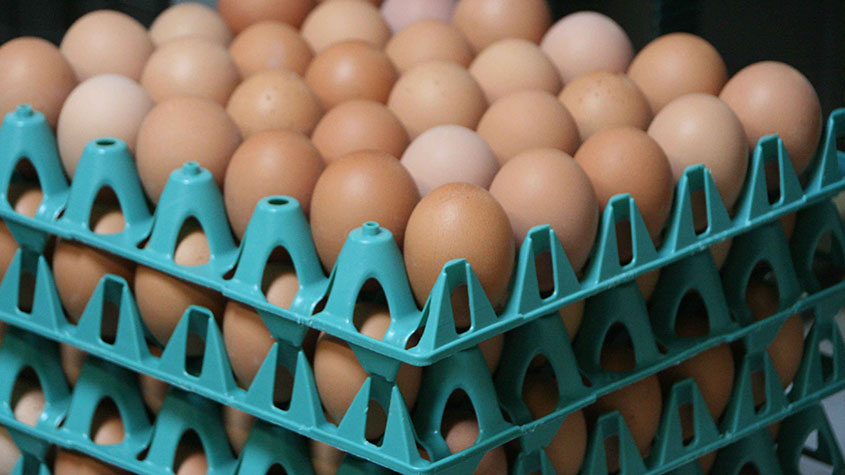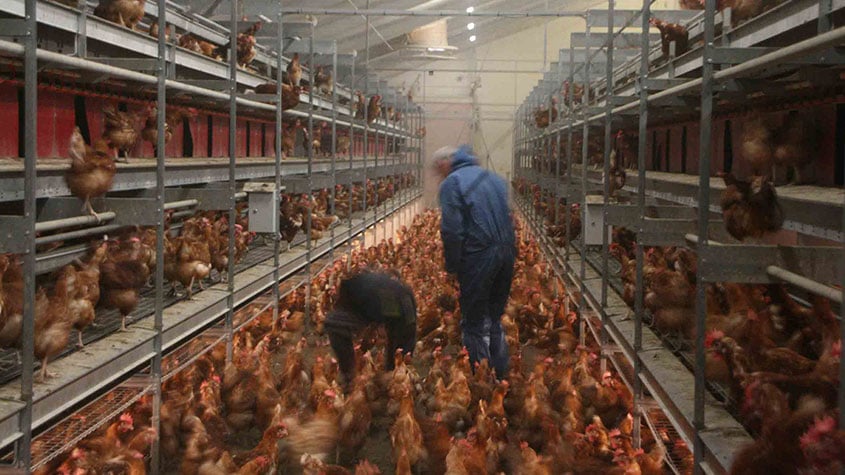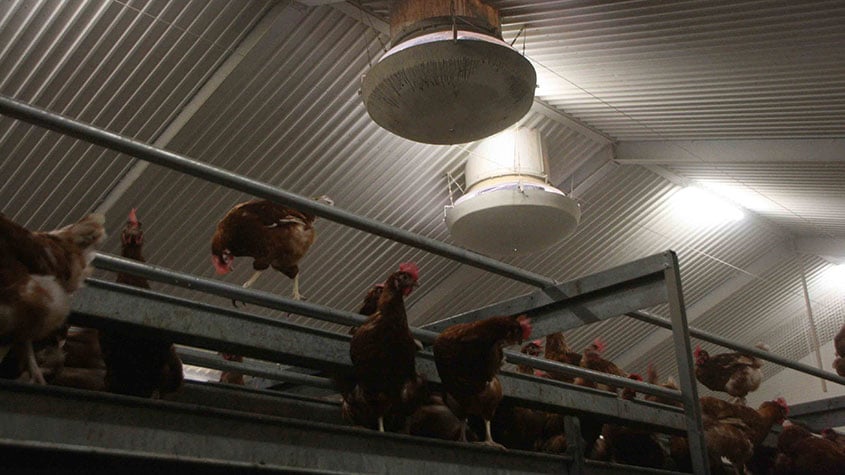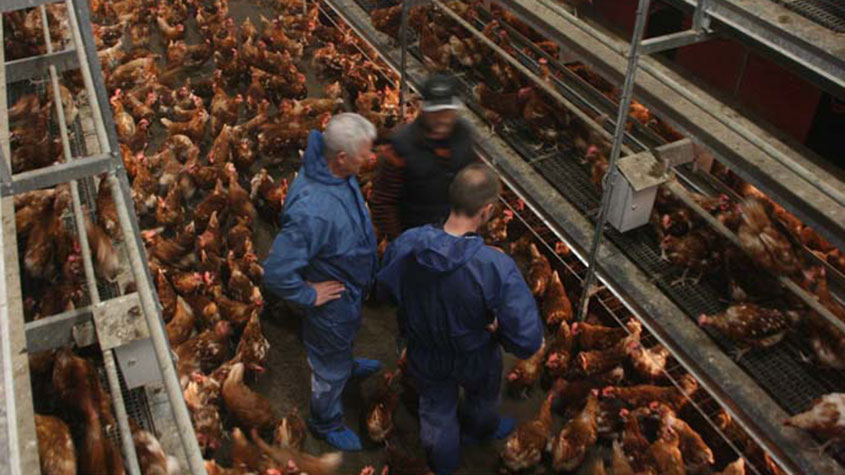Increase egg production and animal welfare in Layers
The various egg production systems that are used all over the world create a need for flexible and reliable ventilation solutions. When mentioning flexibility, the one thing that should not be flexible or random is the cost of running that same ventilation system. Farmers and growers want to know that their ventilation system performs well, but also what the operations costs are.
Whether a layer farmer uses cages, enriched cages, barn, free range, aviary or organic production methods, the climate control system needs to properly ventilate every nook of the building. If there is a sudden cold spell, the system needs to be prepared for adding the right amount of heating power and a system for emergency opening when there is a power loss.
All of the above coupled with sufficient feed and water access makes the laying hens comfortable and healthy, and we all know that this makes them produce better egg quality and improve the number of hen days.
In Munters, we take great pride in being able to deliver an energy efficient and well performing climate control system that fits any of the above mentioned production systems, and also with the objective for the farmer/ grower to have as low Total Cost of Ownership (TOC) as possible to increase farm profit.

Let us look at which parameters we focus on when meeting a farmer. In most cases the production system has been chosen by the farmer which more or less decides the layout and design of the ventilation system. The next thing to take into consideration is the ambient climate condition of the specific location. Average winter & summer temperatures and humidity levels as well as other specific weather types that the climate control system needs to be ready for are carefully collected and investigated. The control unit at the heart of the system will be configured so that it responds to changes in temperature, humidity and eg. strong winds.
In a large hen house there are several design challenges and they are all more or less unique to every layer house we come across, but it is possible to outline some general challenges. One important challenge is to create uniformity, especially in an aviary free range production system. With the hens being free to move around the layer house, this is essential to look at. Uniformity means there can be no cold or warm spots in the house. If that occurs during cold periods, the hens will be clustered around warmer spots and there is a risk of disturbances, overload on the egg handling system or fighting in the flock. The same scenario of clustering will occur during warm periods if there are cold spots, likewise creating an imbalance in the house.
Uniformity always starts with placement of the climate equipment for an even distribution of fresh incoming air and taking stale air out of the house. The type of inlet chosen depends of the climate conditions where the house is located. If the incoming air is cold for a period of the year, one generally wants to avoid that cold air drops down directly towards the birds, something which will inevitably disturb them and cause a non-uniform climate. For these cases, a horizontal and radial spread of air is desired which will mix it with warmer air next to the attic or ceiling before it drops down on the flock.
In the design phase, attention also needs to be paid to the distance between the ceiling/attic air inlets so that the optimum air flow inside the building can be reached.
How do we know that we got it right? Well, there is no second chance; we have to design it correctly from the start. We get a receipt that it is working when you see that the birds are very uniformly spread as in this video, shot in a layer house in Denmark https://www.youtube.com/watch?v=5tsRJQYJOTY
In this video you will probably notice that the inside of the fan looks dirty. These kinds of deposits which are full of grease, feather and dust are normally occurring at any farm, especially towards the end of a flock. It is not possible to go and clean the ventilation equipment during a cycle without considerably disturbing the animals and causing wet litter etc. Before the flock is replaced, the entire house including equipment can be hosed down with high-pressure cleaners and disinfectants. Munters equipment is made for these environments being both dirty and containing high acidity levels.
The second challenge for a climate control system is bedding quality at least for free range production systems where birds move around on the floor. This typically consists of straw, wood shavings or sand.

The layer farmer wants the bedding material to remain dry so that it does not stick to the birds’ feet and ends up in the nests, thereby clinging to the egg shells and causing dirty eggs that the farmer will not get paid for. Wet bedding material mixed with manure will increase the ammonia levels inside the house, affecting both animals and people negatively. A well ventilated building with sufficient air flow and heating on a need basis will ensure that the bedding material is kept dry. So there are lots to win for the farmer when it comes to keeping the bedding material dry; and it all spells better farm economy and improved profits.
The third challenge for the layer farmer affects floor eggs and how to avoid that. It is a cumbersome job to collect these (several times per day), man-hours that could be used for other jobs on the farm, and it could mean a lost income if the floor eggs get dirty. There is actually something that could be done to prevent this from happening also from a ventilation point of view. The ventilation design needs to make sure that there are no drafts in the nesting areas of the layer house. As long as the nesting area is a comfortable zone for the hens, this is where they prefer to lay their eggs and this means that the egg handling system will take care of the product.
The fourth climate challenge for poultry farms is light control. How can lighting be related to climate, you might ask? We’ll get to that, but let us first establish that getting at least eight hours of sleep is crucial for the layer hens. During summer especially in the northern hemisphere, creating eight hours of darkness can be pretty challenging in itself. Pitch-black is not necessary but a brownout effect is. Light spots on the floor or cages are something the farmer would want to avoid since it prevents the chickens from falling asleep. Light spots can be avoided by carefully designing the climate control system and choosing products which counteract light spots. Drip pans underneath chimney fans and deflector disks of ceiling inlets reflect the light from outside back up towards the ceiling or walls. The reflected light does not prevent the birds from getting their rest. By properly configuring the climate system and equipping each project with the products and accessories suitable for that specific location, we can make sure that the farmer doesn’t end up with exhausted animals that don’t thrive or perform well.

Inlets and extraction openings are handled by actuators controlled by a controller. A back up system makes sure that animals are not suffocated should there be a power loss at the farm. The inlets and fan dampers will automatically be set wide open ensuring sufficient natural ventilation airflow in case of emergency such as power loss.
Set at the heart of each climate control system from Munters, you will find a number of controllers which orchestrate the equipment, the silo controller which controls the chicken feed, the Farm Master & Center controllers enabling the farmer to set temperature curves for the building(s), control the minimum ventilation and tracking historical data from his/her house.




